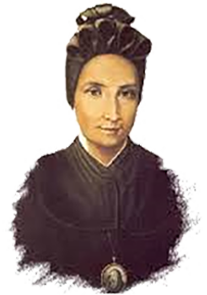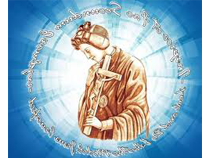Her Birthplace and Childhood
Magdalene of Canossa was born in 1774, the second child of a noble family from Verona,
the Marquis Octavius Canossa and Countess Maria Terese Szluha. The name “Canossa”
has been connected with the history of Italy since the 11th Century A.D.
The famous Countess Matilda (1045-1115) exercised a strong political influence for
nearly half a century. Even though the lineage is not clear, in the 17th century,
the Canossa family in Verona held a prominent position in the city life.
During her early childhood Magdalene experienced deep suffering. At the age of five
her father died in a geological expedition. Her mother remarried shortly after and
left the Canossa Palace and her children behind when Magdalene was seven years of
age. In the absence of parental affection Magdalene turned to Mother Mary for consolation:
"I wept . . . before Mary, invoking her in tears and calling her by the name of ‘mamma!’…
little by little I placed myself in the heart of Mary."
Magdalene was 15 years old when the French revolution broke out and shook the whole
of Europe. In Verona the real consequences were felt about seven years later, when,
on June 10, 1796, General Napoleon entered the city as a conqueror.

Her Search for Meaning
The following year Napoleon was a guest at Canossa Palace and Magdalene, being the
lady of the house, had to do the honours to the General. He would return in 1805
and 1807 as Emperor. On those occasions too he would be a guest at Canossa Palace,
but by that time Magdalene was already undertaking the work she had long wanted
to do.
After the revolutionary upheaval, Magdalene of Canossa, among the most influential
women of her time, was the protagonist of a spiritual rebirth. In addition to her
involvement with a charitable organisation in favour of the wounded and the sick,
Magdalene gave special attention to girls living in poverty and those who had been
abandoned.
She concentrated her efforts and energy on providing a safe place for them, receiving
the first two girls at the “Canossa retreat” in 1801. In that same year Magdalene’s
work earned Napoleon’s admiration for the “Charitable Establishment” erected in
a suppressed Convent in a poor area close to the Palace.
Magdalene’s growing years were marked by suffering and trials. She lived in a society
of contrasts between the very rich and those living in extreme poverty. The hierarchical
society she grew up in was forgetful of God and dominated by arrogance and privileges.
It was in this environment that Magdalene discovered deep within herself the desire
to share the life of Christ in the salvation of many who had been abandoned to their
poverty, exploited by the egoism of the rich and oppressed by the evils of her day.
Magdalene began to give of herself without reserve to children, youth and women
who had to reckon with economic as well as moral, spiritual, intellectual and family
poverty.
Her Goal Fulfilled
In 1808 Magdalene left the Canossa Palace definitively and with some companions,
established herself in the poverty-stricken district of San Zeno where she was happy
to give herself. This small group of women would become the contemplatives not of
the cloister but on the street. Magdalen called her companions “Daughters of Charity”
because their task was to reveal God’s love to humanity through works of charity.
A Heart Open to the World
"The spirit of the Daughters of Charity is to be detached from everything and everybody,
to be available to serve the Lord in every country" (Magdalene of Canossa)
Magdalene’s vision implied a Missionary spirit. She was prepared to go anywhere
and do anything so that Jesus would be known and loved. But this particular dream
was not to be realised in her lifetime. Today the Daughters of Charity living the
spirit of Magdalene are present in 35 countries around the world and the “Canossian
family” comprising Canossian Sons of Charity (priests/brothers), the Secular Missionaries
of St. Magdalene and the Association of the Lay Canossians.
On October 2, 1988 Pope John Paul II proclaimed Magdalene “Saint”, a prophet of
Charity. Magdalene, with her life, has written a significant page in the history
of humanity, a page that speaks of her personal journey in the Spirit, and above
all, of the Greatest Love of Christ in a broken world.

Canossian Charism and Spirituality
Our Foundress, St Magdalene of Canossa possessed deep insights in the human person
in her journey towards fullness of life. In her Plans which she wrote in response
to different requests for her services, she identified 5 different ministries of
charity: education, catechesis/evangelization, pastoral care of the sick, formation
of lay leaders/partners and the Spiritual Exercises.
Magdalene’s whole life was a continuous longing to spread the glory of God especially
through her ministries of charity. For her, the ‘glory of God’ is the manifestation
of his greatness in humanity, of his power and especially of His goodness. The Spiritual
Exercises, or Retreats, was for Magdalene ‘one of the branches of Christian piety
which is most important and beneficial. These are the sacred moments of the year
during which ‘God speaks to the heart of the one who invokes Him in solitude and
silence.’ (Rules and spiritual writings by Magdalene of Canossa)
In the Rules dated 1820, she specifies, “The Institute has taken this branch of
work for no other reason than to procure the spiritual welfare of souls, the good
of their families and above all, the extension of Divine Glory”. This ministry which
appeared initially to be for the noble Ladies alone, is in practice extended to
every category of persons with whom the Sisters come into contact in the ministries.
". . . they receive them in the houses of the Institute those who desire to make the
Spiritual Exercises for 10 consecutive days…at other times of the year, they receive
the young girls . . . "
And for the young women in the residential teachers training courses, Magdalene
provided: “five days of Spiritual Exercises” so that when they return to their homes,
they can spread the knowledge of the Lord” and “devote themselves to working for
the Divine Glory and the good of their souls.” The Spiritual Exercises thus ‘becomes...
the completion and extension of the other branches” of the work of the Daughters
of Charity. In fact, Magdalene was directly organising the retreats herself in the
various Houses and would get others to pray for the fruitfulness of the retreats.